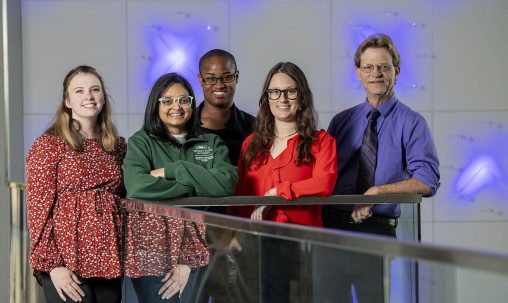
From left: Scout Bowman-Gibson, a dual M.D./Ph.D. student; Mili Bhakta, a biomedical sciences Ph.D. student; Chanel Keoni, research assistant; Madison Stone, a physiology and neuroscience graduate student; and Thomas L. Brown, the associate chair for research and professor of neuroscience, cell biology and physiology and professor of obstetrics and gynecology at the Wright State Boonshoft School of Medicine. (Photo by Erin Pence)
Wright State University pregnancy expert Thomas L. Brown, Ph.D., and two other investigators received a five-year $3.2 million R01 grant to study whether manipulating a gene in the placenta can alter fetal growth and development.
The grant was awarded by the National Institutes of Health through the National Institute of Child Health and Human Development to the University of Colorado.
Brown, the associate chair for research, professor of neuroscience, cell biology and physiology, and professor of obstetrics and gynecology at the Wright State University Boonshoft School of Medicine, is one of three principal investigators involved in the research.
He is collaborating with Thomas Jansson, M.D., Ph.D., the Florence Crozier Cobb Endowed Professor, chief of the Division of Reproductive Sciences and vice chair of research in the Department of Obstetrics and Gynecology at the University of Colorado Anschutz Medical Campus, and Johann Urschitz, Ph.D., assistant professor in the Institute for Biogenesis Research at the John A. Burns School of Medicine University of Hawaii.
Using cutting-edge techniques, the research team will determine whether an amino acid nutrient transporter called Lat1 in the placenta regulates fetal growth and affects long-term outcomes in offspring.
The researchers are studying the gene because it is important for transporting essential amino acids from the placenta to the fetus. The placenta is a unique organ formed only during pregnancy and is required for the growth and survival of the baby. Essential amino acids are required to make proteins, but because they are not produced by the body, they must come from a person’s diet.
“We believe that if this gene that regulates how nutrients are transported back and forth across the placenta is altered, it will impact fetal growth but will also affect the development of the offspring,” Brown said.
Brown’s lab in the Neuroscience Engineering Collaboration Building will use a specialized molecular technique to manipulate the gene in the placenta. Brown’s lab is one of the few in the world with the ability to conduct placental-specific gene transfer.
The researchers hope to determine whether changing the amount of the gene in the placenta will regulate fetal growth and affect a baby’s size.
“We believe the regulation of this gene and how much nutrients it transports across the placenta determines whether the baby will be big or small,” Brown said. “Our preliminary data provides compelling evidence that this is the case.”
Brown said this could lead to new ways to manipulate the gene to control fetal growth.
“That would be truly exciting,” he said. “It would be such a breakthrough.”
Brown and the other researchers are also interested in the gene because it transports thyroid hormone from the mother to the baby. Thyroid hormone is critical for fetal brain development and a lack of thyroid hormone can lead to devastating and irreversible neural cognitive deficiencies in babies.
Brown is a leading expert on preeclampsia, a pregnancy-specific condition. Preeclampsia is a leading cause of maternal and infant illness and death worldwide. It results from abnormal placental development and leads to a rapid and life-threatening rise in the mother’s blood pressure. Preeclampsia can also impair kidney and liver function and lead to seizures in mothers as well as reduced fetal growth and development, leading to smaller or prematurely born babies. Long-term cardiovascular and metabolic effects can also occur in mother and baby.
Brown said he is excited to continue to work with his colleagues to learn more about how fetal growth is determined.
“I’m hopeful our research will provide a strong foundation for taking the next step in determining if we can control how fetal growth is regulated in a positive way for those babies who might be affected,” he said. “We are fortunate to be in this position with this research team where we will have the potential to make a real impact on how babies grow and develop.”

 Wright State psychology team studies ways to identify fatigue in pilots, drivers
Wright State psychology team studies ways to identify fatigue in pilots, drivers  Wright State videographer Kris Sproles wins Regional Emmy and Ohio journalism award
Wright State videographer Kris Sproles wins Regional Emmy and Ohio journalism award  Wright State Boonshoft School of Medicine ranked among the nation’s best for 2024 by U.S. News
Wright State Boonshoft School of Medicine ranked among the nation’s best for 2024 by U.S. News  Exposing biotechnology
Exposing biotechnology  Wright State faculty member Dan Noel uses unique background to inspire new leaders
Wright State faculty member Dan Noel uses unique background to inspire new leaders 